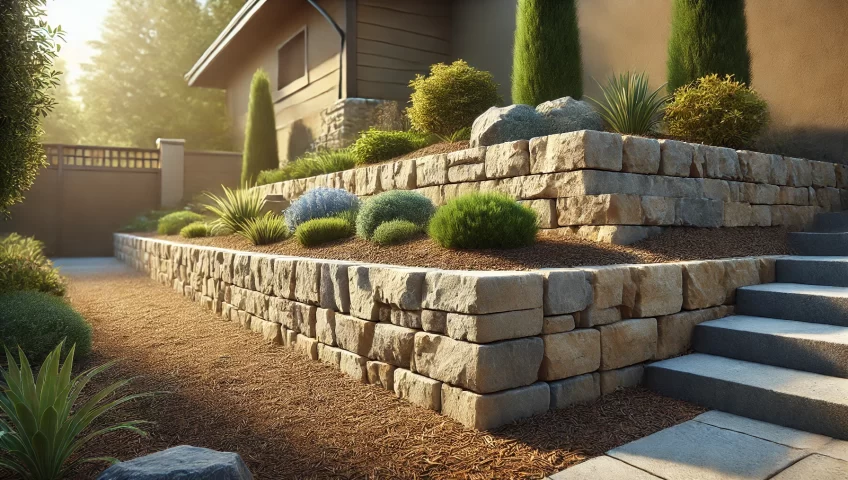Ever thought of building a retaining wall without a single drop of mortar? Dry stack retaining walls are a time-tested landscaping feature that brings charm, strength, and eco-friendliness to any yard. But what exactly is a dry stack retaining wall, and how do you build one that actually lasts?
A dry stack retaining wall is made by carefully arranging and interlocking stones without mortar. It’s a natural and sustainable way to manage slopes, prevent erosion, and enhance your property’s beauty. To get a perfect retaining wall, you should start with a solid foundation and pick angular rocks. From there, use batter, avoid vertical seams, create a rubble and soil core, and use anchors and flat capstones to get it just right.
Whether you’re shaping a garden in Langley or creating a sitting wall in Surrey, dry stack retaining walls offer both structure and style. In this article, we’ll walk you through everything you need to know; from choosing the right stones to the top construction tips every BC homeowner should follow.
What Is a Dry Stack Retaining Wall?
A dry stack retaining wall is a structure made by stacking stones without mortar. It relies entirely on the shape, weight, and placement of each stone to create a stable wall that holds back soil. Unlike traditional concrete or block retaining walls, dry stack walls are built using gravity and craftsmanship.
These walls are not only practical, they’re also beautiful. With their rustic and timeless look, dry stack retaining walls fit naturally into BC landscapes, whether you’re designing a garden bed, levelling a slope, or creating a decorative barrier. They’re also environmentally friendly, using fewer processed materials and allowing water to flow naturally through the gaps.
Dry stack walls have been used for centuries around the world and are still popular today because they’re durable, flexible, and surprisingly low maintenance when built correctly.
10 Tips to Perfect Your Dry Stack Retaining Wall
To get a perfect dry stack retaining wall that’ll last you ages, you have to follow these 10 tips:
Start with a Solid Foundation
Dig a trench at least 4–6 inches deep and about 2 feet wide. Fill it with compacted gravel or crushed stone to ensure good drainage and a stable base, especially important in rainy areas like the Fraser Valley.
Select Flat, Angular Stones
Choose stones with flat, angular faces; they interlock better than rounded ones. Sourcing from local BC stone suppliers can help match your wall to the natural surroundings.
Use the Brick-Laying Rule: Break the Joints
Avoid vertical seams running up the face of your wall. Stagger the joints like you would when laying bricks to add strength and prevent weak points.
Give the Wall a Backward Pitch (Batter)
Lean the wall back into the slope about 1 inch for every 12 inches in height. This helps it resist pressure from the soil behind it.
Tie Stones Through the Wall
Place long, flat stones that reach from the front to the back of the wall every 2–3 feet. These act like anchors, tying everything together.
Keep Large Stones at the Base
Start your wall with the biggest stones. These provide a strong foundation and reduce the risk of settling or shifting over time.
Fill the Core with Rubble and Soil
Backfill behind each course with small stones, soil, and gravel. This improves drainage and strengthens the wall’s structure.
Mind the Face and Slope of Each Stone
Each stone should slope slightly back into the wall. Forward-tilting stones can cause the wall to bulge or collapse.
Cap It Off Right
Use wide, flat capstones on the top course to lock everything in and protect the wall from water infiltration. You can even plant herbs or moss for added beauty.
Maintain and Inspect Your Wall
After a big rain or freeze, give your wall a quick check. Remove weeds, fix loose stones, and refill gaps with small chips to keep the structure tight.
Bonus Tips for Building in British Columbia
- Drainage is crucial. Add drain pipes or weep holes if needed.
- Check local regulations. In some BC municipalities, walls over 4 feet require permits or engineering.
- Use local materials. BC’s natural stone options blend beautifully into the landscape and reduce transport emissions.
New Wave Earthworks. Experts in Hardscaping.
At New Wave Earthworks, we combine expertise with a commitment to quality. We have nearly a decade of experience working on civil, environmental, watershed, and landscape construction projects in Greater Vancouver. We understand client needs, and project demands, and only use the best materials available for affordable rates.
Ready to get started? Contact New Wave Earthworks today for a consultation and see how Allan Block walls can transform your property. Call us at (604) 855-2603 or mail us at info@newwaveearthworks.com to get a free quote today!
Conclusion
A dry stack retaining wall combines timeless beauty with lasting strength; no mortar is required. To build one that lasts you years, you should consider hiring experts for the job. Use the tips here as a checklist to ensure that you’re being offered the best possible service.


